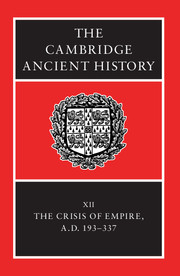Book contents
- Frontmatter
- PART I NARRATIVE
- PART II GOVERNMENT AND ADMINISTRATION
- PART III THE PROVINCES
- 8 Provinces and frontiers
- 9 Developments in provincial and local administration
- 10 Egypt from Septimius Severus to the death of Constantine
- PART IV THE ECONOMY OF THE EMPIRE
- PART V THE NON-ROMAN WORLD
- PART VI RELIGION, CULTURE AND SOCIETY
- Chronology
- Bibliography
- Index
- Topographical map of the Roman empire
- Map 2 The Roman empire in a.d. 211
- The Roman empire in a.d. 314
- The Rhine–Danube limes in the late second century
- References
8 - Provinces and frontiers
from PART III - THE PROVINCES
Published online by Cambridge University Press: 28 March 2008
- Frontmatter
- PART I NARRATIVE
- PART II GOVERNMENT AND ADMINISTRATION
- PART III THE PROVINCES
- 8 Provinces and frontiers
- 9 Developments in provincial and local administration
- 10 Egypt from Septimius Severus to the death of Constantine
- PART IV THE ECONOMY OF THE EMPIRE
- PART V THE NON-ROMAN WORLD
- PART VI RELIGION, CULTURE AND SOCIETY
- Chronology
- Bibliography
- Index
- Topographical map of the Roman empire
- Map 2 The Roman empire in a.d. 211
- The Roman empire in a.d. 314
- The Rhine–Danube limes in the late second century
- References
Summary
FRONTIER HISTORY
Under the Severan emperors there was a significant advance of the limits of territory under direct Roman occupation, in Mesopotamia to the river Tigris and in Africa to the northern fringes of the Sahara desert. There were also major campaigns in northern Britain but any intended increase in the extent of northern Britain under direct Roman control was cancelled by the death of Septimius Severus. Only in the later years of Severus Alexander, last of the Severan dynasty, were there indications of new threats to stability along the northern and eastern frontiers.
The exceptional concentration of Roman military manpower in northern Britain remained, on paper at least, unaltered throughout the period. Hadrian's demarcation of Roman territory by the patrolled barrier between Tyne and Solway was in the end preferred to the shorter Forth–Clyde line established by his successor. Treaty arrangements with peoples beyond the frontier broke down during the reign of Commodus but it remains far from clear why Severus should have judged that disturbances on the fringes of one of Rome's remotest provinces demanded the continuing presence of the emperor and his court from 208 until his death early in 211. Apparently successful sea-borne operations against the Maeatae and Caledonii from bases such as Cramond on the Forth and Carpow on the Tay were not intended to re-establish a Roman occupation of the Forth–Clyde line. Caracalla's settlement was to bring a long period of stability to the province and was accompanied by a continuation of the comprehensive reconstruction of existing Roman bases and roads begun by Severus after his victory over Clodius Albinus in 197.
- Type
- Chapter
- Information
- The Cambridge Ancient History , pp. 212 - 268Publisher: Cambridge University PressPrint publication year: 2005
References
- 28
- Cited by

